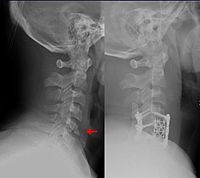
Photo from wikipedia
Background The number of complications after total elbow arthroplasty (TEA) is high and survival rates are low compared to hip and knee arthroplasties. The most common reason for revision is… Click to show full abstract
Background The number of complications after total elbow arthroplasty (TEA) is high and survival rates are low compared to hip and knee arthroplasties. The most common reason for revision is aseptic loosening, which might be caused by overloading of the elbow. In an attempt to lower failure rates, current clinical practice is to restrict activities for patients with a TEA. However, postoperative management of TEA is a poorly investigated topic, as no evidence-based clinical guidelines exist and the aftercare is often surgeon-based. In this study we evaluated the current postoperative management of TEA among orthopedic surgeons. Methods An online survey of 30 questions was sent to 635 members of the European Society for Surgery of the Shoulder and the Elbow (SECEC/ESSSE), about 10% (n = ± 64) of whom are considered dedicated elbow specialists. The questions were on characteristics of the surgeon and on the surgeon’s preferred postoperative management, including items to be assessed on length of immobilization, amount of weight bearing and axial loading, instructions on lifelong activities, physiotherapy, and postoperative evaluation of the elbow. Results The survey was completed by 54 dedicated elbow specialists from 17 different countries. Postoperative immobilization of the elbow was advised by half of respondents when using the triceps-sparing approach (52%), and even more with the triceps-detaching approach (65%). Postoperative passive movement of the elbow was allowed in the triceps-sparing approach (91%) and in the triceps-detaching approach (87%). Most respondents gave recommendations on weight bearing (91%) or axial loading (76%) by the affected elbow, but the specification shows significant variation. Conclusion The results from this survey demonstrate a wide variation in postoperative care of TEA. The lack of consensus in combination with low survival rates stresses the need for clinical guidelines. Further research should focus on creating these guidelines to improve follow-up care for TEA.
Journal Title: PLOS ONE
Year Published: 2022
Link to full text (if available)
Share on Social Media: Sign Up to like & get
recommendations!